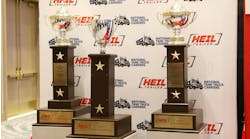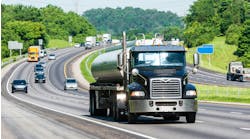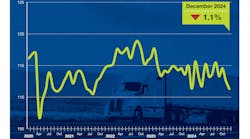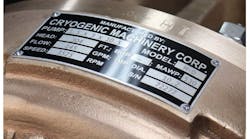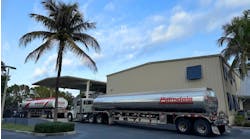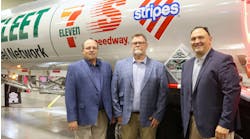BeyondTrucks expands integration hub
PSG acquires cryogenic pump manufacturer
Constant refinement of safety program brings Groendyke Transport it’s eighth Outstanding Safety Performance Trophy
IT’S one for the record books.
Groendyke Transport Inc, Enid, Oklahoma, has now claimed a record-setting eighth Outstanding Safety Performance Trophy in the National Tank Truck Carriers annual Competitive Safety Contest.
The achievement spans five decades across two centuries, with Outstanding Safety Performance trophies earned in 1973, 1975, 1990, 1991, 1999, 2000, 2016, and now 2018. After Groendyke Transport, the nearest competitor claims five trophy wins.
Groendyke Transport won its eighth NTTC Outstanding Safety Performance Trophy in the Harvison Division, which is for tank fleets running more than 15 million miles. Mike Elmenhorst, Groendyke Transport safety manager, was named NTTC Safety Professional of the Year for the Harvison Division. The carrier competed in the 40- to 90-million mile category and achieved a frequency of just 0.462 accidents per million miles.
“It’s always exciting to win the Heil Trophy,” says Greg Hodgen, president and chief executive officer of Groendyke Transport. “Put simply, winning that trophy has become a part of our safety culture at Groendyke Transport. It is ingrained on our corporate DNA. The Heil Trophy is the Super Bowl of safety for the tank truck industry, and we want to win it every year.
“Our drivers regularly ask for updates on our pursuit of the Outstanding Safety Performance Trophy. They want to know that they are still in the running for it. Everybody wants to be a winner, and they want to be recognized for doing a job well. They never want to give up on that trophy.
“We always want to be competitive in the NTTC’s safety contest. However, more to the point we want to keep our drivers safe, protect the public, and safeguard our customers’ products.
Elmenhorst adds that winning the Heil Trophy means so much. “It means that the safety culture we built at this company really makes a difference,” he says. “This is why we start every year saying that we will contend for the Heil Trophy. It demands a top-down effort and takes all 1,600 employees to build a winning program.”
Constant tweaking
Maintaining a trophy-worthy safety program takes constant effort and a willingness to pursue safety improvement without compromise. It means steadily tweaking driver training programs and ferreting out the latest in safety technologies (or developing its own systems when necessary).
Safety was very much a consideration last year when Groendyke Transport executives negotiated the largest fleet acquisition in the carrier’s history. Completed in early 2019, Groendyke Transport acquired all of the tank truck assets of McKenzie Tank Lines Inc, which was based in Tallahassee, Florida.
The acquisition increased Groendyke’s terminal count from 30 to more than 40 and added about 200 drivers, bumping Groendyke’s total driver force to approximately 1,150. The acquisition significantly expanded Groendyke’s presence in the Southeast. The addition of MTL’s business is expected to increase Groendyke’s revenues by more than $40 million in 2019 to approximately $280 million.
Today, Groendyke Transport operates more than 1,100 tractors and 1,500 trailers. The carrier serves customers in 49 US states, Canada, and Mexico. The carrier hauls primarily bulk liquids, including refined fuels, lube oils, asphalt, and specialty chemicals.
Common culture
After the McKenzie Tank deal closed, Hodgen said: “It has been our long-time goal to expand our operations in the Southeast. “Our two companies have so much in common—from history to culture and values to emphasis on safety—this deal made perfect sense. We believe their people will make a great fit with our culture and way of running our business. We are excited to have them as Groendyke Transport employees.”
Groendyke officials noted that McKenzie Tank Lines was long been recognized as a trendsetter in the safety arena, as one of the first adopters of collision mitigation systems and blind-spot detection systems, and as a participant in a public-private partnership in the early 2000s designed to accelerate the development of such technology.
Communication may be the biggest key to success in Groendyke Transport’s trophy-winning safety program. The carrier is absolutely relentless in communicating its safety message—both internally and externally.
On the external side, Groendyke Transport was the first to find a marketing value in the Outstanding Safety Performance Trophy. After winning its third trophy in 1990, the carrier placed a full-page advertisement prominently featuring the trophy in the Enid newspaper and sent copies of the ad to all of its customers.
“Even today, we want our customers to know about our history of safety achievement,” Hodgen says. “It’s part of delivering peace of mind and business continuity to them. It’s not just about winning a trophy, though. It’s a company-wide desire to build the best safety program in the industry.”
Communicating Safety
Internally, the carrier is even more dogged in delivering the safety message. “When I joined Groendyke Transport as a driver in 1997, we had already won four trophies, two of them back to back,” Elmenhorst says. “The desire to win more trophies for excellent safety performance was strong. The focus on safety really clicked in my mind.”
Most of the carrier’s drivers now have the Groendyke app on their cell phones. With it, drivers can access Mobile Minutes, safety videos, and other short videos.
“Communication is a big part of safety, and we use this app to tell drivers that what they do is important,” Hodgen says. “Safety and everything else they do is important.”
Elmenhorst adds that the Groendyke app has made a world of difference when it comes to communicating management’s message across the entire company. “We offer reminders on the competition for the Outstanding Safety Performance Trophy,” he says.
Communication is a big part of the Groendyke Transport effort to take driver management to a higher level. “We want a consistent message, and we want to be consistent in the way we work with our drivers,” Hodgen says.
Driver performance is getting more attention, as is driver training. “Drivers must want to be the best,” Hodgen says. “They can’t be complacent. If a driver doesn’t think safety is the most important thing, we are not going to be successful.”
The carrier has begun scheduling annual driver performance reviews that take about an hour. Additional reviews are scheduled as needed. The reviews look at all aspects of driver performance.
“Part of our objective in the review process is to show drivers that it is alright to talk about incidents,” Hodgen says. “We also use the reviews as a way to identify and keep good drivers.”
More training
More driver training is being scheduled, and the training program has been strengthened. Five field training coordinators manage the program and about 150 certified driver instructors are in place across the company.
“Drivers encounter a very different world when they come on board with us,” Elmenhorst says. “Our drivers live and breathe our in-house-developed Value Driven Driving System. We address the risks of distracted driving in detail. We teach our drivers that anyone can stop a work operation if they feel that what they are doing is unsafe.”
Training for a newly hired driver begins with a two-day on-boarding session at the home terminal. That is followed by five days of classroom and hands-on instruction at the Enid training center. Retraining is scheduled as needed.
Training systems at the center include custom-built simulators for petroleum and chemical loading racks. The focus is on DOT407 and DOT406 trailers.
Safety meetings
Safety meetings are held monthly, and attendance impacts safety bonuses. Safety banquets are held once a year at every terminal, and about 65% of the drivers attend the events.
“Members of our executive team are at every banquet,” Hodgen says. “There is a saying that no fertilizer is as good for a field as a farmer’s footprints. We need to meet with our drivers to understand their issues and concerns.”
Even as the carrier refines its communications and training efforts to deliver a consistent safety message across the entire company, it has made a significant investment in technology to ensure that drivers have the safest possible work environment while on the road.
By the end of 2019, Groendyke Transport will have spent upwards of $11.2 million since the company bean specing collision mitigation, air disc brakes, side radar, lane departure systems, automated transmissions, and trailers with brake warning devices.
Plans are underway to test cameras on side mirrors to help eliminate blind spots. “We can’t get rid of all blind spots, but we will do our best,” Elmenhorst says.
Pulsing light
In the drive to provide the safest work environment, the carriers sometimes has to develop its own solutions. A recent example is the amber brake-activated pulsating lamp now being installed on Groendyke Transport trailers in addition to the steady-burning brake lamps required by the Federal Motor Carrier Safety Regulations (FMCSR).
It took five years to gain approval for the pulsing amber brake light from the Federal Motor Carrier Safety Administration. Even with plenty of data showing that the lamp reduced rear-end collisions, FMCSA was only willing to grant a temporary five-year exemption that only applies to Groendyke Transport trailers at this time.
“You sometimes wonder how motorists don’t see a big truck in front of them, but rear-end accidents are a significant problem for the trucking industry,” Hodgen says. “We have video showing that this pulsing amber light really makes a difference, and that data shows we cut rear-end collisions by 30%.”
FMCSA officials acknowledge that placing a brake-activated pulsating lamp, in addition to the required steady-burning brake lamps, on the rear of Groendyke Transport’s trailers would likely achieve a level of safety equivalent to or greater than the level of safety provided by the federal brake light regulation.
“We’ll continue to manage technology to ensure that our drivers have the safest possible workplace just as we will continue to refine our driver training and communications processes,” Hodgen says. “And in the process, we’ll always be competing for that next Outstanding Safety Performance Trophy.”
